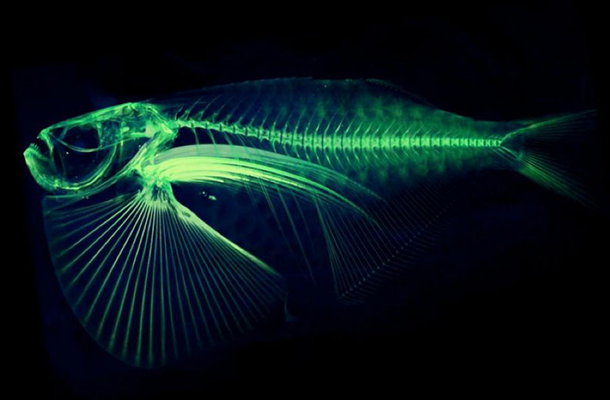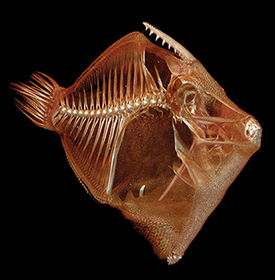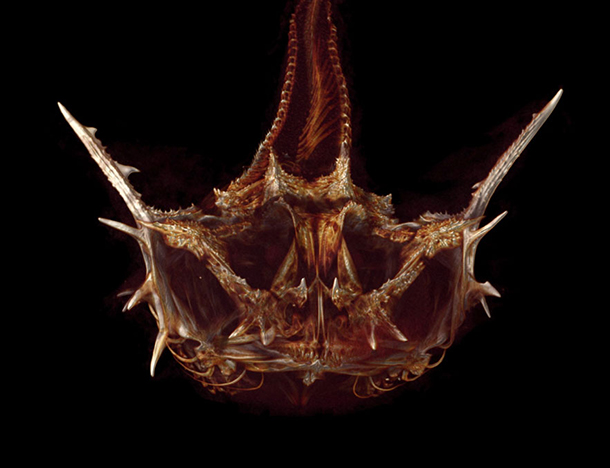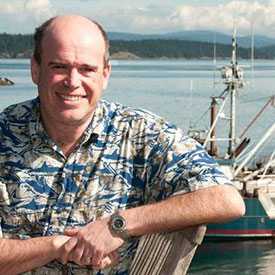'Fish Guy' Aims To Scan All The Fishes
Air Date: Week of September 16, 2016

A digitized CT scan of spotfin hatchetfish (Thoracocorax stellatus). (Photo: courtesy of Adam Summers, University of Washington)
University of Washington biology professor Adam Summers has a deep ambition: to make CT scans of every species of fish in the world, and he is well on his way. Summers tells host Steve Curwood how he is achieving this goal and why researchers anywhere have free access to this growing database of digitized images.
Transcript
CURWOOD: It’s Living on Earth, I’m Steve Curwood. Some people think big, really big, and that's certainly true of University of Washington biology professor Adam Summers. Often called "the fish guy", Professor Summers wants to make CAT scans of every species of fish on Earth. He also advised the Pixar company on how fish move for the films, "Finding Nemo" and "Finding Dory". To find out how he expects to achieve his hugely ambitious goal we called him up at his lab on San Juan Island off Seattle, Washington. Adam Summers, welcome to Living on Earth.
SUMMERS: Thank you for having me, Steve.
CURWOOD: So CT scans, CAT scans of every fish on the planet seems like a monumental task. So why are you doing it? Why are you doing this?
SUMMERS: [LAUGHS] I'm doing it because I have a deep fascination with fishes. I mean, a fascination with fishes that started when I was probably two or three years old and proceeded through the sort of fish tanks and fishing and building fly rods and tying flies to giant nets and big tanks and basically devoting my life to doing research on them. And I find their skeletons endlessly fascinating, I mean, just full of fabulous data that I can extract for all sorts of purposes.
CURWOOD: So what do you think all these CT scans will show that we don't already know?
SUMMERS: Well, every single CT scan that I look at I see things we didn't know. I can give you an example. One of the most iconic wrasses - You can look this up on YouTube - is a thing called a Slingjaw wrasse. This animal shoots its jaw out the full length of its head to catch prey. I mean, just explodes out of its head, and the front end is been looked that really deeply. A friend brought one by and he said, "You know, could you CT scan this too, just throw this into your project?" And I grabbed it, and I CT scanned it, and I found that the ribs at the back end of the fish, the end that nobody has looked at are fused. They make a continuous connection between the back end of the dorsal spine, the spinal column, the ribs through to the anal fin spine. It's a huge defensive bulk work against being grabbed by a predator. We had no idea it was there because we've never looked at the skeleton. So skeletons are woefully understudied, and here's an avenue for recording basically everything that's on the inside that's hard tissue.

Digitized CT image of a spadenose clingfish (Cochleoceps spatula). (Photo: courtesy of Adam Summers, University of Washington)
CURWOOD: So how do you get this image? I mean does the wrasse stay still or does he have to sacrifice his life for science?
SUMMERS: Well, the wrasse comes to me dead. I scan museum specimens, specimens that have collection data that have a place in a museum so that someday, if someone needs to know something about that particular animal, they can go back and get the very one that we CT scanned, and we have scanned specimens from all the great collections in the United States and several from around the world.
CURWOOD: Aha. OK, I don't have probably enough fingers for this, but how many species of fish are there and how many have you scanned so far?
SUMMERS: So, more or less 33,000.
CURWOOD: OK.
SUMMERS: And we're just clearing 600.
CURWOOD: You have a ways to go.
SUMMERS: We do have a ways to go, but we have been doing it for very long. So we've been doing it since about February and really the big breakthrough came because I, I just got this question over and over again. I use Twitter a fair bit, so I would tweet out these skeletons. I'd say, “Here's my latest CT scan skeleton,” and people would tweet back and say, “Oh, what's up next?” And I'd say, “I can't tell you. I want to scan all of them. I want to scan all fish.” And at the time I was saying it, it seemed like a joke because 33,000, I mean, you pick a number...an hour two hours to scan...three hours to scan. That's more hours than I have left in my career, so it was kind of a joke. But then we realized that we could package these fish up. If you've ever had a CT scan, or seen someone get a CT scan, they get stuck in a donut and the donut passes over their body or their body passes through the donut. Everything in that donut gets scanned, the table they're lying on and, most importantly from my point of view, the air that surrounds them. It would be much more efficient when we CT scan someone if we just piled up all the sick people at once on the table...
CURWOOD: [LAUGHS]
SUMMERS: .. and shoved them through the doughnut all at once because that would be very efficient and then we scan them and then afterwards we digitally dissect them. Well, that's what we do with the fish. We're not scanning one fish at a time we're scanning 20 so it's not 33,000 scans that we have to do it's more like 1,500 and that becomes a manageable number, and it's important that this is, you know, this scan-all fishes-initiative has touched off a really interesting project run by this guy Dave Blackburn at the University of Florida, to scan all vertebrates. You think I'm ambitious...33,000. He's going to scan every vertebrate, so I am a cog in his machine.
CURWOOD: OK, how many vertebrate species are there?
SUMMERS: Oh we're talking 60, maybe, 60,000. So he's into it. He's doing every single one.
CURWOOD: I'm assuming when you do 20 of these, that they're laid out in a row there.
SUMMERS: No.
CURWOOD: They're all stacked on each other?

Digitized CT image of a fringed filefish (Monocanthus ciliatus). (Photo: courtesy of Adam Summers, University of Washington)
SUMMERS: Here's what we do. So we get in a shipment of fishes from a museum. We arrange them all so they're in the same size class, right? We want all the fish about the same size, and then we take wet cheesecloth because these are in ethanol, these fishes, and we've got to keep him perfectly damp otherwise they dry out, and curl, and museum curators get really angry at me. And you sit there and you put one fish down and you take a photograph of it and you put a little letter on it that's radio opaque so you can tell one from another. Then you roll it in a little bit of cheesecloth and then you set the next fish down, and you take another picture of that one with the little letter on and you keep rolling and rolling and rolling until you have 10, maybe even 20, fish in a big burrito and then you slide this burrito into a can, into a plastic can that we 3D print and you put that plastic can in the CT scanner.
CURWOOD: Huh, I don't know how tasty that burrito would be, Doctor.
SUMMERS: It would be vile, it would be absolutely horrendous tasting because ... not only are fish just terrible to eat. Fish that have been fixed in formalin and then stored in ethanol are just terrible things.
CURWOOD: Oh, wait, you don't eat fish?
SUMMERS: No, I don't.
CURWOOD: They are your friends.
SUMMERS: They are my friends. Fish are my friends.
CURWOOD: OK, now how do you handle something like a whale shark or an ocean-going sunfish?
SUMMERS: So, I've scanned ocean sunfish already.
CURWOOD: That's a big CT scan.
SUMMERS: Nope, because you're forgetting all of them start out really small.
CURWOOD: Oh, babies. [LAUGHS]
SUMMERS: I've scanned the little guys. So I have larval sunfish that I've scanned and you can grab off the twitter feed. You can see these things called ranzania laevis. They're gorgeous spiky little things that look really nothing like the adult, but they're pretty cool. So it's a legitimate question to ask, how am I going to get the big ones? How am I going to get the rare ones? The truth is I'm unconcerned. I mean, if I can get to 30,000 and there's 3,000 left, we're down to the seeds and stems. I mean I'll go to Boeing and use their big CT scanner that they use for jet engines. I'll do whatever I need to do to get the last big ones, but right now the average bony fish is 30 centimeters. I can fit all the average and below fish in, no problem.
CURWOOD: So, so far your workaround about the big fishes are taking pictures of them when they are little, but sometimes they don't look much like their daddies.
SUMMERS: No, there's a huge transformation in most fish between what we call the larval stage and the juvenile stage. Larval fish often look absolutely nothing like the juveniles. So we have typically scanned things from juveniles up to adults, and we're limited in size. So when someone gave me a chance to scan some larval sunfish I jumped at it. They're fabulous looking fish and they're very different than the adults. Someday, we'll get the juvenile and get it in the CT scanner but as juveniles they are the size of dinner plates, so you know even as juveniles they're not little teeny-tiny things.
CURWOOD: So how did you get involved with doing CT scans anyway?
SUMMERS: Well, I've been CT scanning fish since about 1994 or 5, and I got into it because I worked on stingrays that eat hard prey. And these have a cartilagenous skeleton, and they crush snail, and they crush mussels and things for their diet. And I couldn't really understand how that could happen. So I wanted to CT scan some of them, and I wanted to scan a Spotted Eagle ray at first, a beautiful, beautiful fish, to show all of the mineral that was in this cartilage. And what was really neat was, you go around to all these hospitals and say, "Excuse me, um, I'm a graduate student, and I've got a big dead fish I want to CT scan." And invariably, they sort of looked at me like I was completely insane and said, "That's a fabulous idea, but you can't come anywhere near our CT scanner with your big dead fish."
Eventually I found a place that was willing to, if I came at night, let me scan a well wrapped fish, and so I scanned them, and the first time I saw the inside of that skeleton, and I hadn't cut it. You know, I had dissected them all the time, but here was everything in situ, here was everything arranged the way it should be arranged, not arranged the way it happens when you pull apart the tissue and look inside. I was knocked out. I thought this is, this is the best, this is how we have to do this. So I started CT scanning every fish I could find. You know, and I proceeded along. It's very expensive, and we never had any money for this. We never had any funding. So I would beg the CT scan techs to scan stuff for me. I'd give them print outs of the pictures so they could see why we wanted to do it, you know. I think my oddest bartering element was, I had a guy at a CT scan, he was a CT scan tech, he had the use of a CT scanner, and he loved Snickers bars. And I could go in there with a bag of fish and a pocket full of Snickers bars, and he’d let me scan all night.

Digitized CT image of an antlered sculpin (Enophrys diceraus). (Photo: courtesy of Adam Summers, University of Washington)
So, what happened was about a year ago we raised private funds to make the Karel F. Liem Biovisualization Center, and that facility, one of the conditions of these donations which bought a $340,000 CT scanner, one of the conditions was that anyone be allowed to use it for free. There's no disposable costs in a CT scanner, so, you know, it's like turning on and off a light switch. Eventually the bulb fails, but there's a little electricity cost, you get light for free. So, I started circulating the word, you know, "Bring your fish. Let's get everything scanned." And then, we figured out how to scan multiple things at once, and realized we have a shot at actually scanning the vast majority of fish. So these private donors really enabled this project.
CURWOOD: And now you have your own scanner, you don't have to trade Snickers bars, huh.
SUMMERS: I know. The best thing is the Snicker bars come to me. [LAUGHS]
CURWOOD: [LAUGHS] OK. So you mentioned that this process has allowed you to apparently identify new species.
SUMMERS: Yes.
CURWOOD: What are some of the other rewards? What are some of the things that you have found using CT scanning?
SUMMERS: So I'm a biomechanist. I'm an undergraduate trained engineer and mathematician who took a PhD in biology after spending a lot of time not doing biology, and what I do as a biologist is, I look for new technological solutions inspired the living world, typically fish, but not always. And I look for new kinds of materials, new ways of doing things that have been, you know, the way an animal lives, and I find inspiration there. So we’ve looked at how fish stick to things. Looking at CT scans of these fish that stick to rocks? These fish stick to rocks that are incredibly irregular. Just basically imagine yourself at the seaside in the crashing waves. You grab a rock. Look at that rock. It's rough, you know, it's not smooth, it's all beaten up and it's covered in snot. It's covered in living crap that's growing on it.
There's a fish called a Cling Fish that can stick to that, and it can stick to it with 300 times its body weight, and so we what to know how it sticks. The underlying skeleton for that disc is fascinating and shows you not just how it sticks but how it releases. Then you say, well, what's the use of that? Well, think about the inside of you. You got all sorts of irregularly shaped parts that are slick and covered with crap, and it would be kind of cool if we could open you up and use these suction cups inspired by fish to hold things up and move things from one place to another without grabbing on with, you know, rough pinchers and things which is the current state-of-the-art. So we used it to understand how that skeleton works.
I'm very interested in armor, how are you go through trade-offs of being really well armored and yet still be able to move, and so I've got a lot of CT scans of an armored group of fish called Poachers and we're trying to understand how that armor grows, how they start out as flexible little fish and turn into these little tanks. So those are couple of things that, you know, I use this in my own research.
CURWOOD: Adam, before you go, tell me how can other researchers get access to your digital images of these fish and what ways are they using them so far?
SUMMERS: So I think my favorite thing about this project is we make the data available free for anyone to use for any purpose immediately after we get it. So, we put it up on a something called MorphoSource and another site Open Science Framework, and you can go there and get the sliced data and you can do anything you want with it.

Adam Summers, also known as “the Fish Guy” (Photo: Adam Summers)
You want to make, uh, you wanted set up your own phylogenies and measure your own morphological characters? Absolutely, go for it. Do science. But if you're just a dad who wants to make a Christmas tree ornament for his kid out of their favorite fish, there you go. You could do that too. And if you're an entrepreneur who wants to make helmets that looked just like fish heads, go for it. The data is there. It's for you. So we make this available, open source, completely free for anyone to use. And I think that's one of the coolest things about it. It's inspiring all kinds of research and also other outreach things that we never would've thought.
CURWOOD: Adam Summers is a biology professor at the University of Washington. Thank you so much, Adam. Keep on taking those pictures.
SUMMERS: Thanks a lot, Steve. It was nice talking to you.
CURWOOD: And if you dive into our website LOE.org, you'll find some fishy pictures.
Links
Chicago Tribune: “Washington scientist launches effort to digitize all fish”
Adam Summers on Perfecting the Science in Pixar’s Finding Dory
Living on Earth wants to hear from you!
Living on Earth
62 Calef Highway, Suite 212
Lee, NH 03861
Telephone: 617-287-4121
E-mail: comments@loe.org
Newsletter [Click here]
Donate to Living on Earth!
Living on Earth is an independent media program and relies entirely on contributions from listeners and institutions supporting public service. Please donate now to preserve an independent environmental voice.
NewsletterLiving on Earth offers a weekly delivery of the show's rundown to your mailbox. Sign up for our newsletter today!
 Sailors For The Sea: Be the change you want to sea.
Sailors For The Sea: Be the change you want to sea.
 The Grantham Foundation for the Protection of the Environment: Committed to protecting and improving the health of the global environment.
The Grantham Foundation for the Protection of the Environment: Committed to protecting and improving the health of the global environment.
 Contribute to Living on Earth and receive, as our gift to you, an archival print of one of Mark Seth Lender's extraordinary wildlife photographs. Follow the link to see Mark's current collection of photographs.
Contribute to Living on Earth and receive, as our gift to you, an archival print of one of Mark Seth Lender's extraordinary wildlife photographs. Follow the link to see Mark's current collection of photographs.
 Buy a signed copy of Mark Seth Lender's book Smeagull the Seagull & support Living on Earth
Buy a signed copy of Mark Seth Lender's book Smeagull the Seagull & support Living on Earth

